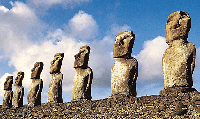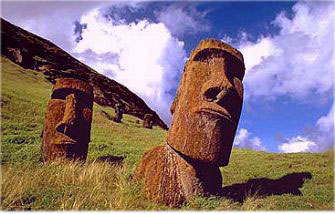Interpretations - Mystical Places - Easter Island

Easter Island, in the South Pacific Ocean, is famous as the site of enormous statues of people that were carved hundreds of years ago. The island lies about 2,300 miles (3,700 kilometers) west of Chile. Easter Island has been governed by Chile since 1888.

Easter Island covers 64 square miles (166 square kilometers). Its soil is stony. The only fresh water comes from wells, tanks (pools), and crater lakes in the island's three extinct volcanoes. About 2,000 people live on the island. Most of the people are Polynesians. The rest are Chileans. Spanish—the language of Chile—is the official language. But both Spanish and a Polynesian language called Rapanui «RAH puh NOO ee» are spoken. Easter Island's Spanish name is Isla de Pascua. Its Polynesian name is Rapanui. Tourism and the production of wool for export are the main industries.
Scientists believe that Easter Island was settled about A.D. 400, but they are not sure who the first inhabitants were. Some say they were American Indians, and others believe they were Polynesians.
The early islanders created the famous statues, which are called moai. The statues were possibly intended to honor ancestors. Today, more than 600 statues are scattered on the island. Most are from 11 to 20 feet (3.4 to 6 meters) tall. Some rise as high as 40 feet (12 meters) and weigh as much as 90 tons (82 metric tons). The islanders used stone hand picks to carve the statues from the rock of an extinct volcano. They set up the statues on raised temple platforms called ahu. Huge red stone cylinders were balanced on the heads of some of the statues, like hats. Even today, erecting such large statues and balancing the cylinders on top of them would be a difficult feat.
A bloody war between two groups of Easter Islanders broke out about 1680. During the following period of about 150 years, the victors in the war and their descendants toppled the moai from their platforms, in most cases breaking the necks of the statues. About 15 moai have been restored to their original positions.
Jacob Roggeveen, a Dutch explorer, was the first European to see Easter Island. He discovered it on Easter Sunday, 1722, and gave the island its name. In 1862, slave ships from Peru arrived at the island. Their crews kidnapped about 1,400 Easter Islanders and brought them to Peru to work on plantations. All but 100 of these islanders died in Peru. The survivors were taken back to Easter Island in 1863. During the voyage home, 85 islanders died. The 15 survivors carried home the germs of smallpox and other diseases, which spread to remaining islanders. Many of the islanders died from the diseases.
During the early 1870's, many Easter Islanders left their homeland. In 1877, only 110 people remained there. Since then, the native population has grown and Chileans have moved to the island.

more information coming soon.
return to top >
|




